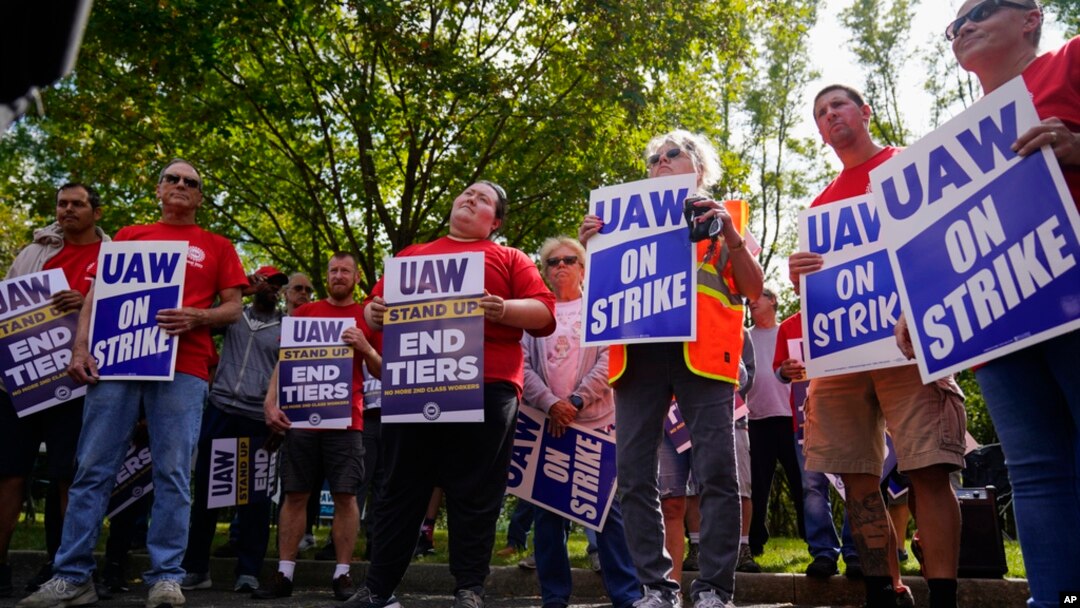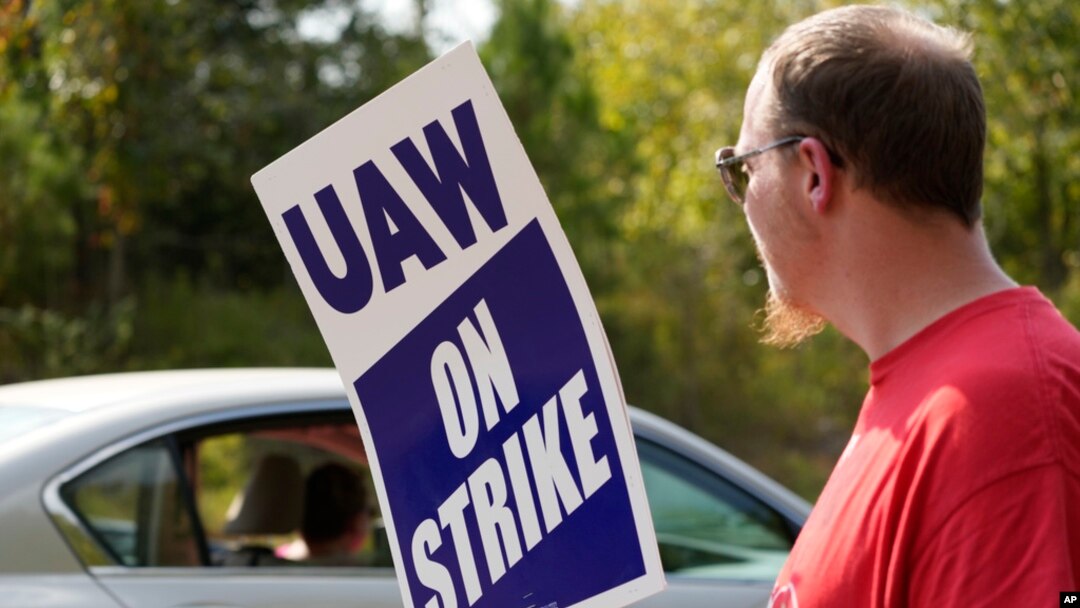The United Auto Workers union announced an expansion of its strike against two of the three largest auto manufacturers in the U.S. on Friday, sending workers to the picket lines at 38 parts distribution centers across 20 states.
The escalation of the strike, which began on September 15 at just three factories, targeted only General Motors and Stellantis. The other member of the Big Three, Ford, was exempted from further walkouts. UAW President Shawn Fain said Friday morning that talks between the union and Ford had made significant progress.
“We do want to recognize that Ford is showing that they're serious about reaching a deal,” Fain said in an address livestreamed to UAW members. “At GM and Stellantis, it's a different story.”
The new job action, which took effect at noon Eastern time, could severely limit the ability of auto dealerships and repair shops to get the spare parts they need to continue operations.

United Auto Workers members and supporters picket outside a General Motors facility in Langhorne, Pa., Sept. 22, 2023.
New approach
The UAW strike takes place as the union is seeking new employment contracts at all three of the large automakers. Among other things, workers are demanding a 36% pay increase spread over four years, and the elimination of wage tiers and extended temporary employment arrangements that have allowed the companies to pay some workers significantly less than others doing similar jobs.
The union says that the carmakers have earned record profits in the past decade, pointing to rising executive salaries and shareholder-friendly stock buybacks as evidence. Fain has frequently railed against what he describes as the “corporate greed” that prevents workers from receiving their “fair share.”
The walkout follows a different path from earlier UAW job actions. In the past, the union has typically targeted just one of the Big Three at a time, using the contract ultimately negotiated through the strike as a template for agreements with the remaining two.
Fain and the UAW leadership team took a different approach this time, beginning the strike at one factory belonging to each of the three and promising a gradual but unpredictable escalation if negotiations did not bear fruit. Until the announcement on Friday morning, neither the carmakers nor the rank-and-file UAW members themselves knew where the next walkouts would take place.
‘Innovative strategy’
Jasmine Kerrissey, director of the Labor Center at the University of Massachusetts-Amherst, told VOA that one benefit of the UAW’s strategy of gradual escalation is that it focuses public attention on its efforts.
“It keeps the strike in the news cycle,” said Kerrissey, co-author of Union Booms and Busts: The Ongoing Fight over the U.S. Labor Movement. She noted that public opinion polling shows that the strikers currently enjoy broad public approval, adding, “Historically, public support has been very important in resolving strikes in unions’ favor.”
Todd Vachon, director of the Labor Education Action Research Network at Rutgers University, agreed, calling the UAW’s approach an “innovative strategy” that has other benefits as well.
“It gives them a little bit of a carrot and a stick in the strike process, which is not typically the case,” he told VOA. “Generally you walk out, and you've pulled all of your ammunition, and that's it. That's your big guns, and you have nothing further that you can add to that. This gives them the ability to continue to ramp up and also to be targeted in terms of which employers are coming to the table and actually negotiating issues compared to the other.”
United Auto Workers members and supporters picket outside a General Motors facility in Langhorne, Pa., Sept. 22, 2023.
Carmakers respond
In public comments, the carmakers have characterized the UAW’s demands as unrealistic and the union’s rhetoric about the companies as misleading.
In an op-ed in the Detroit Free Press on Wednesday, GM President Mark Reuss said the union’s claims that the company does not pay a living wage are false, and he described as “untenable” its demands for large pay increases.
“Amid the rhetoric of the United Auto Workers leadership, the flow of misinformation is not fair to anyone,” Reuss wrote. “It can be hugely counterproductive to reaching an agreement that gets the GM team back to work quickly, which should be everyone’s goal.”
On Friday, The Detroit News reported that it possessed text messages sent by a senior UAW official claiming that the aim of the strike was to inflict “recurring reputations damage and operational chaos” on the Big Three. “(I)f we can keep them wounded for months they don’t know what to do. The beauty is we’ve laid it all out in the public and they’re still helpless to stop it.”
All three automakers reacted to the report, with Ford and Stellantis characterizing it as “disturbing” and “incredibly disturbing,” respectively. GM released a longer statement to the paper saying, “It’s now clear that the UAW leadership has always intended to cause monthslong disruption, regardless of the harm it causes to its members and their communities. … The leaked information calls into question who is actually in charge of UAW strategy and shows a callous disregard for the seriousness of what is at stake.”
Time of change
With public interest in electric vehicles growing, and government mandates pushing the industry to manufacture more of them, the Big Three are caught in the especially tricky position of trying to ramp up production of EVs while continuing to successfully make and market vehicles powered by internal combustion engines.
At the same time, much of their major competition in the EV field, like electric vehicle manufacturer Tesla, has no legacy manufacturing operations to manage at all.
“The incumbents have to deal — on a daily minute-to-minute basis — with two sets of very different operating systems,” K. Venkatesh Prasad, senior vice president of research and chief innovation officer with the Center for Automotive Research, told VOA.
Anxiety about that transition is not limited to management, but confronts labor as well.
While a switch to EVs may or may not translate into a change in the number of people employed by the industry, it will certainly alter the skills required to build their products. This has many UAW members concerned about their future employment.
“There's a stark, unambiguous transformation at play right now, as we speak,” Prasad said.


